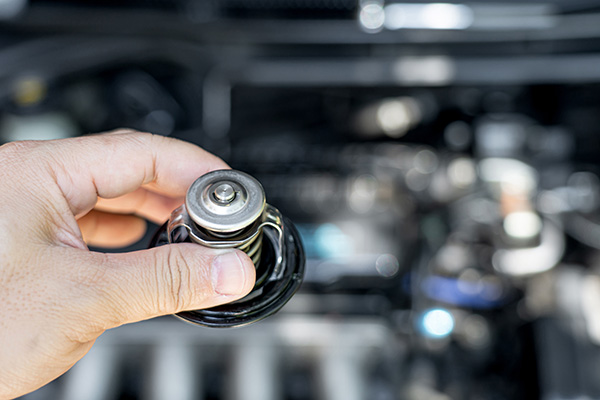
The thermostat in your car regulates the engine temperature. It opens and closes depending on how hot or cold the engine is, helping coolant flow through the system when needed. When the thermostat functions correctly, your engine stays within its ideal temperature range. But when it gets stuck (either open or closed), it can lead to performance issues or even engine damage.
Here’s how to recognize when your thermostat isn’t working like it should.
What the Thermostat Actually Does
The thermostat is a valve located between the engine and the radiator. When you start your car, the thermostat remains closed so the engine can warm up quickly. Once the engine reaches a certain temperature, the thermostat opens to allow coolant to circulate and maintain a steady temperature.
This on-off process keeps the engine from overheating and also prevents it from running too cold. But when the valve gets stuck, either in the open or closed position, that balance is thrown off.
Signs the Thermostat Is Stuck Closed
A thermostat stuck in the closed position keeps coolant from flowing to the radiator. This can cause the engine to overheat, especially once it warms up and starts working harder.
Here are some symptoms that point to a closed thermostat:
- Rising temperature gauge: If the needle climbs into the red zone soon after you start driving, it may mean coolant isn't circulating.
- Lack of heat in the cabin: Since coolant isn’t moving through the heater core, you might not get warm air through your vents.
- Steam from the hood: Overheating can cause coolant to boil and turn into steam. If you notice this, pull over and turn the engine off immediately.
- Coolant overflow or smell: Excess pressure can cause coolant to escape the overflow tank, and you might smell it burning near the engine.
Engine overheating can lead to serious damage, including warped cylinder heads or a blown head gasket, so this is a situation that shouldn’t be ignored.
Signs the Thermostat Is Stuck Open
On the flip side, if the thermostat is stuck open, coolant flows constantly even when the engine is cold. This might seem harmless, but running an engine too cold for too long can also create problems.
Here’s what to watch for:
- Temperature gauge stays low: The engine never reaches normal operating temperature, especially in colder weather.
- Poor fuel economy: A cold engine burns more fuel. You may find yourself filling the tank more often.
- Weak cabin heat: With coolant flowing before the engine is warm, you may only get lukewarm air from the heater.
- Check engine light: In some cases, the car’s computer detects inefficient engine operation and stores a trouble code.
While a stuck-open thermostat may not damage the engine as quickly as an overheating situation, it still leads to inefficient performance and potential long-term wear.
How to Confirm a Thermostat Problem
If you’re noticing these symptoms, a technician can confirm the issue through a few tests. They might use a temperature gun to check the heat difference between the engine and radiator hoses, or monitor live temperature data from the car’s sensors using a scan tool.
In most cases, replacing a faulty thermostat is a straightforward repair. It's also smart to inspect the condition of the coolant itself, as old or contaminated coolant can contribute to sticking or corrosion inside the thermostat housing.
Can You Drive With a Bad Thermostat
It depends. If your car is running cold, you might be able to get away with short trips for a little while, but you’ll likely see reduced performance. If the engine is overheating, though, driving even a few miles can cause serious damage.
The moment you suspect your thermostat is failing, it’s best to schedule an inspection. Fixing it early is far cheaper than dealing with the consequences of overheating.
Thermostat Replacement at B & L Automotive in Newport News, VA
If your engine temperature is all over the place or you’re not getting enough heat inside your car, it could be time to check the thermostat. At B & L Automotive in Newport News, VA, our team can diagnose the issue and replace the thermostat if needed, so your engine runs efficiently and safely through any season.